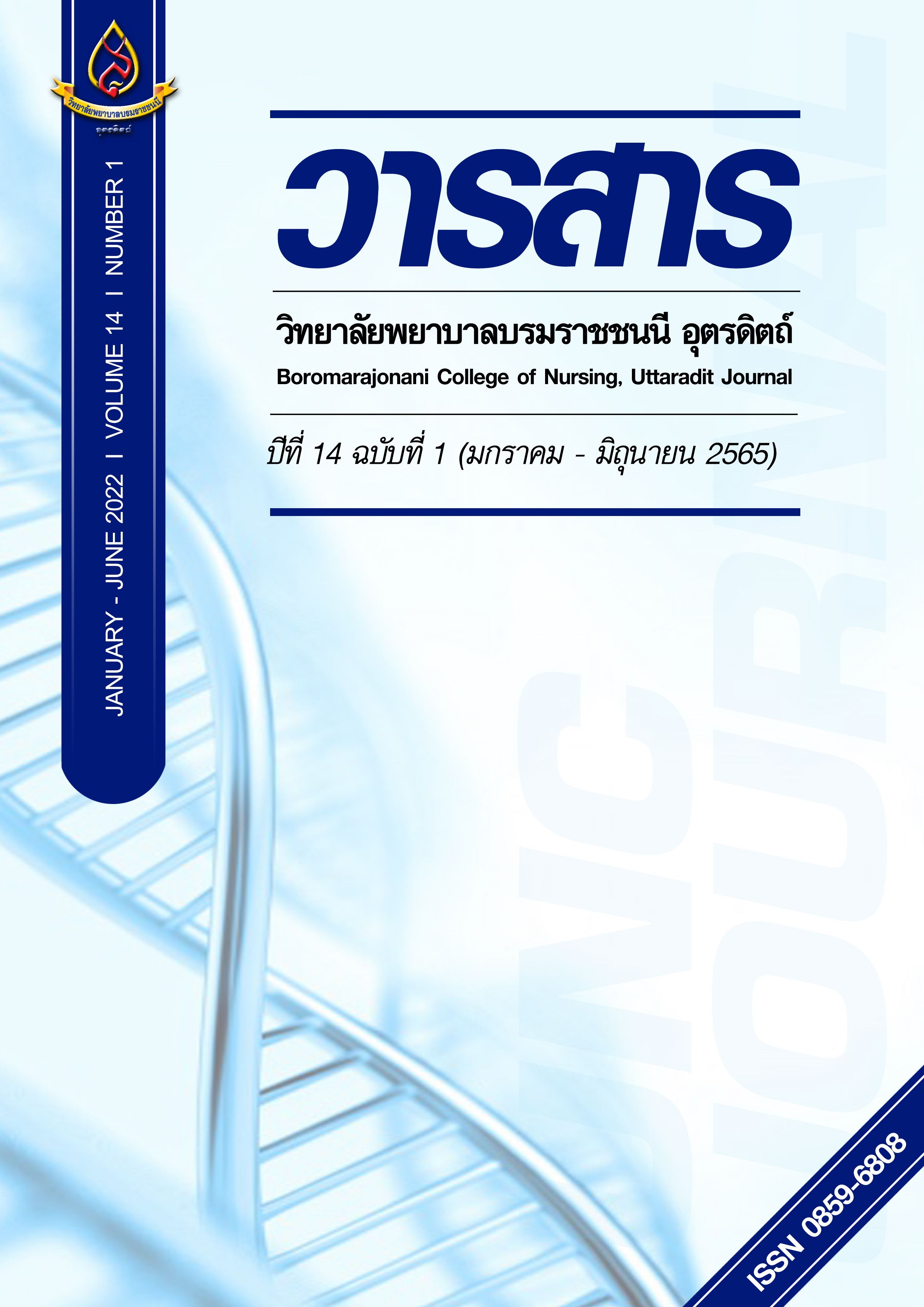ปัจจัยที่มีผลต่อการดูแลสุขภาพผู้ที่มีภาวะพึ่งพิงด้านสุขภาพของผู้ดูแลveเภอศรีสัชนาลัย จังหวัดสุโขทัย
Main Article Content
บทคัดย่อ
การศึกษาครั้งนี้มีจุดมุ่งหมายเพื่อศึกษาการดูแลสุขภาพผู้ที่มีภาวะพึ่งพิงด้านสุขภาพของผู้ดูแลและศึกษาปัจจัยที่มีผลต่อการดูแลสุขภาพผู้ที่มีภาวะพึ่งพิงด้านสุขภาพของผู้ดูแล อำเภอศรีสัชนาลัย จังหวัดสุโขทัย กลุ่มตัวอย่าง คือ กลุ่มผู้ดูแลหลักดูแลสุขภาพผู้ที่มีภาวะพึ่งพิงด้านสุขภาพ จานวน 190 คน คำนวณกลุ่มตัวอย่าง โดยการใช้สูตรประมาณค่าสัดส่วน สุ่มตัวอย่างแบบชั้นภูมิอย่างเป็นสัดส่วน ศึกษาช่วงเดือนพฤศจิกายน 2560 ถึง มกราคม 2561 เครื่องมือที่ใช้ในการเก็บรวบรวมข้อมูลเป็นแบบสอบถาม วิเคราะห์ข้อมูลด้วยสถิติเชิงพรรณนา ได้แก่ ค่าความถี่ ร้อยละ ค่าเฉลี่ย และส่วนเบี่ยงเบนมาตรฐาน วิเคราะห์อำนาจการทานายด้วยสถิติการถดถอยพหุคูณแบบ stepwise
ผลการศึกษา พบว่า ผู้ดูแลผู้ที่มีภาวะพึ่งพิงด้านสุขภาพ ร้อยละ 72.6 มีการดูแลสุขภาพอยู่ในระดับดีมาก ปัจจัยที่มีผลต่อการดูแลผู้ที่มีภาวะพึ่งพิงด้านสุขภาพของผู้ดูแล ได้แก่ แรงสนับสนุนทางสังคมในการดูแลผู้ที่มีภาวะพึ่งพิงด้านสุขภาพ (Beta=.364, β=1.109) การรับรู้ (Beta=0.228, β=.454) ระยะเวลาการดูแล (Beta=-.230, β=-.452) อายุ (Beta=.168, β=.178) ความรู้ในการดูแล (Beta=-.138, β=–.852) และระดับการศึกษา (Beta=.134, β=13.632) โดยปัจจัยดังกล่าวสามารถร่วมกันพยากรณ์การดูแลสุขภาพของผู้ดูแลผู้ที่มีภาวะพึ่งพิงได้ร้อยละ 39.1 อย่างมีนัยสำคัญทางสถิติที่ระดับ .05 ดังนั้นควรมีการสนับสนุนผู้ดูแลเกี่ยวกับข้อมูลข่าวสาร การดูแลสุขภาพที่ถูกต้อง เพื่อเพิ่มประสิทธิภาพการดูแลผู้ที่มีภาวะพึ่งพิงด้านสุขภาพ
Article Details

อนุญาตภายใต้เงื่อนไข Creative Commons Attribution-NonCommercial-NoDerivatives 4.0 International License.
บทความหรือข้อคิดเห็นใดใดที่ปรากฏในวารสารวิจัยการพยาบาลและวิทยาศาสตร์สุขภาพ เป็นวรรณกรรมของผู้เขียน ซึ่งบรรณาธิการหรือสมาคมศิษย์เก่า ไม่จำเป็นต้องเห็นด้วย และบทความที่ได้รับการตีพิมพ์เผยแพร่ถือเป็นลิขสิทธิ์ของวารสารวิจัยการพยาบาลและวิทยาศาสตร์สุขภาพ
เอกสารอ้างอิง
Best, J. (1977). Research in education. New Jersey: Prentice Hell.
Bloom, B.S. (1968). Mastery learning. UCLA – CSEIP Evaluation Comment. 1 (2) Losangeles. University of California at Los Angeles.
Caplan, RD. et al. (1976). Adtering to medical Regimens: pilot experimental in patient education and social support. Ann arbour: University of Macihigan.
Chiaprasert, S. (2020). Prevention of pressure ulcers for stroke patients at home: experience developing caregiver relatives in the 4.0 era. Journal of Faculty of Nursing, Burapha University, 28(1), 105-115. (in Thai).
Chickering, A.W. (1969). Education and identity. Jossey-Bass series in higher education, San Francisco.
Green, L.W. (1980). Health education planning: a diagnostic approach. Mayfield Publishing, California.
Junpunyaskool, O. (2017). Perception of illness among caregivers of children with acute illness and related factors. Nursing Journal, 45(1), 75-86. (in Thai).
Janz, N.K., & Becker, M.H. (1984). The health belief model: a decade later. Health Education Quarterly, 11, 1-47.
Kanrat K., Pongthavornkamol K., & Wattanakitkrileart D. (2016). Factors associated with perception of quality of care in cancer patients during hospitalization. Chulalongkorn Medical Journal, 60(5), 523 – 34
Layothee, P. (2019). Caregiver burden and depression among caregivers of individuals with visual impairment. Srinagarind Medical Journal, 34(4), 354-360. (in Thai).
Leelapattana, V. & Hatthirat, S. (2020).Working with caregiver burnout. Retrieved (2020, November 14) from https://www.rama.mahidol.ac.th/fammed/th/postgrad/article_4
Meecharoen, W. (2014). Cancer caregiver relatives: adjustment to roles and quality of life enhancement. Ramathibodi nursing journal, 20(2), 10-22. (in Thai).
Mueanchoo, S. (2014). To study factors that could predict the stress-coping ability of caregivers of spinal cord injury patients. Thai Journal of Nursing Council, 31(1), 124-136. (in Thai).
National Statistical Office Ministry of Digital Economy and Society. (2019). Annual report for the disabled 2017. Retrieved (2019, September 25) from http://www.nso.go.th (in Thai).
Niyomsats, K., Niyomkar, S., & Lamchang, S. (2020). Factors related to caregiver participation in treatment decision-making for children with cancer receiving chemotherapy. Nursing Journal, 47(1), 66-79. (in Thai).
Norkaeo, D, & Kaewmanee. C. (2016). Factors influence caregiver burden of stroke caregivers. UMT POLY Journal. 14(2), 251-262. (in Thai).
Office of the National Economic and Social Advisory Council Office of the Civil Service Commission. (2016). Population structure. Retrieved (2017, September 25) from https://moc.ocsc.go.th (in Thai).
Orem, D. E. (1991). Nursing: Concepts of Practice (4 th ed.). St. Louis: Mosby.
Pianpanassak, J. & Soonthornvipart, L. (2017). Readiness of patient’s relatives in patient care before returning: the case of medicine ward, police hospital. Retrieved (2017, September 25)
from http://mapol.soc.ku.ac.th/wpcontent/uploads/2017/09/12.pdf (in Thai).
Pender, N.J. (1987). Health promotion in nursing practice. 2nd ed. Connecticus: Appleton & Lange.
Rovinelli, R. J., & Hambleton, R. K. (1977). On the use of content specialists in the assessment of criterion-referenced test item validity. Dutch Journal of Educational Research. 2, 49-60.
Rosenstock, I. M., Strecher, V. J., & Becker, M. H. (1988). Social learning theory and the Health Belief Model. Health Education Quarterly, 15(2), 175–183.
Seenak, T., Nukaew, O., & Suttharangsee, W. (2017). Factors predicting caregivers’ capabilities in caring for older Persons with major depressive disorder (MDD). The Southern College Network Journal of Nursing and Public Health, 5(2), 216-230.
(in Thai).
Si Satchanalai Hospital. (2017). Medical records. Sukhothai: n.p. (in Thai).
Somdej Phra Sangkharajyanasangvara Institute of Medicine for the Elderly. (2015). Long-term care policy for the elderly. Retrieved (2015, September 9) from http://agingthai.dms.go.th /agingthai/ (in Thai).
Sukhothai Provincial Health Office. (2019). Public Health Performance Summary Report 2019. Retrieved (2019, November 5) from https://www.skto.moph.go.th/home.php (in Thai).
Udonsat, S. et al. (2018). Male Caregiver Burden of Elderly with Stroke and Its Related Factors. Academic Conference and Presenting national research results 3rd Academic Scholarship "Innovation that transforms the global society", 451-461. N.P. (in Thai)
Vanichbuncha, K. (2008). Multivariate analysis. Bangkok: Chulalongkorn University. (in Thai)


